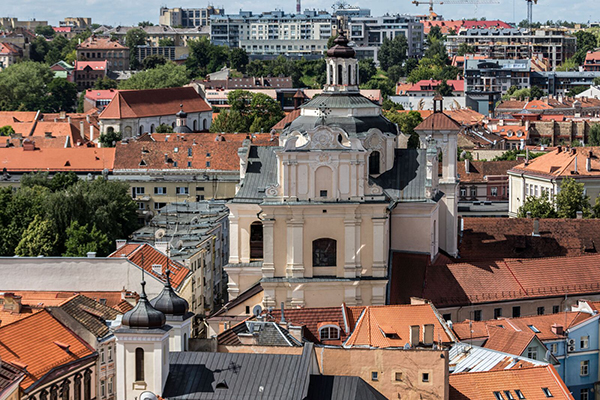This Church is included as part of the following itineraries: The Way of Mercy, Dominicans in Vilnius.
It is believed that the first Gothic church at this location stood since the times of Grand Duke Gediminas and was destroyed by the crusaders. In 1408 Vytautas the Great built a new church. At the beginning of the 16th century Alexander, the Grand Duke of Lithuania and King of Poland transferred it to the Dominican Order.
After several fires in the 17th century, the Church of the Holy Spirit was reconstructed in a Late Baroque style. The Church interior, decorated in a Rococo style, is regarded as one of the most treasured Lithuanian church interiors. The Church is also renowned for its almost-original 18th-century organ, sixteen altars, and for its crypts, which for centuries have been used as a burial place for residents of the City, victims of plague and other epidemics, and the soldiers of Napoleon’s Army. After the uprisings of the 19th century, tsarist authorities closed the Dominican monastery and established a magistrate office, apartments, a prison, and secret institutions supporting the war industry, on its premises.
In 1986, due to the initiative of the pastor of the Holy Spirit parish and current Bishop of Grodno, Aleksander Kaszkiewicz, the original image of Divine Mercy was returned from Belarus and, after restoration, displayed in this Church for public veneration. In 1993, during his visit to Lithuania, St. John Paul II prayed in front of the image of Divine Mercy and met with Lithuanians of Polish origin and Lithuania’s Polish Catholics. A memorial plaque was placed near the entrance of the Church to commemorate the event. Following the renovation of the nearby Church of the Holy Trinity, Cardinal Audrys Juozas Backis founded the Shrine of Divine Mercy on this site. The image of Divine Mercy was relocated to this Shrine pursuant to the decree of the Cardinal in 2005.
In 2015 the Archbishop of Krakow, Stanislaw Dziwisz, presented a relic of St. John Paul II’s blood to the parish of the Holy Spirit. The relic, which is especially precious to the parishioners, is incorporated into St. John Paul II’s altar, located in the right nave of the Church.
Monday–Friday – 10 a.m.–7 p.m.
Saturday – 9 a.m.–5 p.m.
Sunday – 6.30 a.m.–5 p.m.
Monday–Friday – 3 p.m., 6 p.m.
Saturday – 3 p.m.
Sunday – 8 a.m., 9 a.m. (for children), 10.30 a.m.,
12 p.m. (for youth), 1.30 p.m., 6 p.m.





